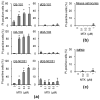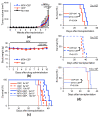Targeting Folate Metabolism Is Selectively Cytotoxic to Glioma Stem Cells and Effectively Cooperates with Differentiation Therapy to Eliminate Tumor-Initiating Cells in Glioma Xenografts
- PMID: 34769063
- PMCID: PMC8583947
- DOI: 10.3390/ijms222111633
Targeting Folate Metabolism Is Selectively Cytotoxic to Glioma Stem Cells and Effectively Cooperates with Differentiation Therapy to Eliminate Tumor-Initiating Cells in Glioma Xenografts
Abstract
Glioblastoma (GBM) is one of the deadliest of all human cancers. Developing therapies targeting GBM cancer stem cells or glioma stem cells (GSCs), which are deemed responsible for the malignancy of GBM due to their therapy resistance and tumor-initiating capacity, is considered key to improving the dismal prognosis of GBM patients. In this study, we found that folate antagonists, such as methotrexate (MTX) and pemetrexed, are selectively cytotoxic to GSCs, but not to their differentiated counterparts, normal fibroblasts, or neural stem cells in vitro, and that the high sensitivity of GCSs to anti-folates may be due to the increased expression of RFC-1/SLC19A1, the reduced folate carrier that transports MTX into cells, in GSCs. Of note, in an in vivo serial transplantation model, MTX alone failed to exhibit anti-GSC effects but promoted the anti-GSC effects of CEP1347, an inducer of GSC differentiation. This suggests that folate metabolism, which plays an essential role specifically in GSCs, is a promising target of anti-GSC therapy, and that the combination of cytotoxic and differentiation therapies may be a novel and promising approach to effectively eliminate cancer stem cells.
Keywords: JNK; RFC-1; anti-folate; brain tumor initiating cells; glioma stem cell; serial transplantation assay.
Conflict of interest statement
The authors declare no conflict of interest.
Figures






Similar articles
-
A novel drug conjugate, NEO212, targeting proneural and mesenchymal subtypes of patient-derived glioma cancer stem cells.Cancer Lett. 2016 Feb 28;371(2):240-50. doi: 10.1016/j.canlet.2015.11.040. Epub 2015 Dec 9. Cancer Lett. 2016. PMID: 26683773
-
Repurposing FDA approved drugs inhibiting mitochondrial function for targeting glioma-stem like cells.Biomed Pharmacother. 2021 Jan;133:111058. doi: 10.1016/j.biopha.2020.111058. Epub 2020 Dec 8. Biomed Pharmacother. 2021. PMID: 33378970 Free PMC article.
-
Combined expressional analysis, bioinformatics and targeted proteomics identify new potential therapeutic targets in glioblastoma stem cells.Oncotarget. 2015 Sep 22;6(28):26192-215. doi: 10.18632/oncotarget.4613. Oncotarget. 2015. PMID: 26295306 Free PMC article.
-
Collateral damage control in cancer therapy: defining the stem identity in gliomas.Curr Pharm Des. 2011;17(23):2370-85. doi: 10.2174/138161211797249198. Curr Pharm Des. 2011. PMID: 21827417 Review.
-
New advances of microRNAs in glioma stem cells, with special emphasis on aberrant methylation of microRNAs.J Cell Physiol. 2014 Sep;229(9):1141-7. doi: 10.1002/jcp.24540. J Cell Physiol. 2014. PMID: 24374932 Review.
Cited by
-
Quantifying the activity profile of ASO and siRNA conjugates in glioblastoma xenograft tumors in vivo.Nucleic Acids Res. 2024 May 22;52(9):4799-4817. doi: 10.1093/nar/gkae260. Nucleic Acids Res. 2024. PMID: 38613388 Free PMC article.
-
Targeting Bcl-xL with Navitoclax Effectively Eliminates Senescent Tumor Cells That Appear Following CEP-1347-Induced Differentiation of Glioma Stem Cells.Int J Mol Sci. 2025 Jul 20;26(14):6984. doi: 10.3390/ijms26146984. Int J Mol Sci. 2025. PMID: 40725230 Free PMC article.
-
Clinical and translational advances in primary brain tumor therapy with a focus on glioblastoma-A comprehensive review of the literature.World Neurosurg X. 2024 Sep 21;24:100399. doi: 10.1016/j.wnsx.2024.100399. eCollection 2024 Oct. World Neurosurg X. 2024. PMID: 39386927 Free PMC article. Review.
-
Lysine catabolism reprograms tumour immunity through histone crotonylation.Nature. 2023 May;617(7962):818-826. doi: 10.1038/s41586-023-06061-0. Epub 2023 May 17. Nature. 2023. PMID: 37198486 Free PMC article.
-
To Explore the Stem Cells Homing to GBM: The Rise to the Occasion.Biomedicines. 2022 Apr 24;10(5):986. doi: 10.3390/biomedicines10050986. Biomedicines. 2022. PMID: 35625723 Free PMC article. Review.
References
-
- Okada M., Takeda H., Sakaki H., Kuramoto K., Suzuki S., Sanomachi T., Togashi K., Seino S., Kitanaka C. Repositioning CEP-1347, a chemical agent originally developed for the treatment of Parkinson’s disease, as an anti-cancer stem cell drug. Oncotarget. 2017;8:94872–94882. doi: 10.18632/oncotarget.22033. - DOI - PMC - PubMed
MeSH terms
Substances
Grants and funding
LinkOut - more resources
Full Text Sources
Medical
Research Materials

